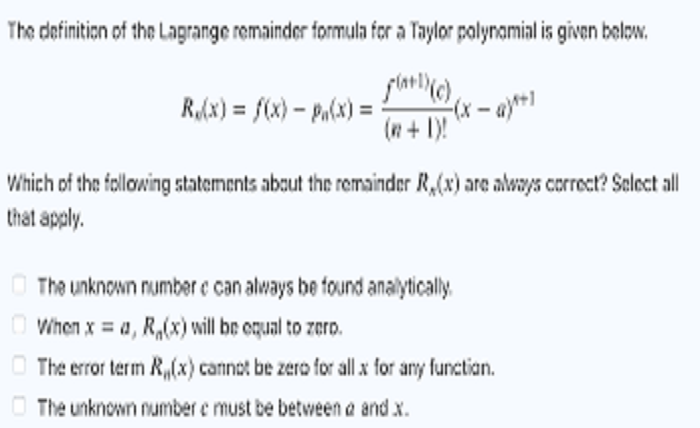
Introduction
The Lagrange Error, often encountered in calculus and numerical analysis, is a critical concept for understanding the accuracy of polynomial approximations. This guide delves into the intricacies of Lagrange Error, explaining its significance, applications, and how it can be calculated and minimized.
What is Lagrange Error?
Lagrange Error, named after the mathematician Joseph-Louis Lagrange, measures the error introduced when approximating a function using a polynomial. This error quantifies how close a polynomial approximation is to the actual function, providing insights into the approximation’s accuracy.
Read more about: home-workify
Importance of Lagrange Error
Understanding Lagrange Error is crucial in numerical analysis and calculus. It allows mathematicians and engineers to estimate how accurate their polynomial approximations are, which is essential in various fields like physics, engineering, and computer science.
The Mathematical Foundation of Lagrange Error
Lagrange Error is derived from Taylor’s Theorem, which states that any smooth function can be approximated by a polynomial. The error term, known as the Lagrange Error term, indicates the difference between the function and its polynomial approximation.
How to Calculate Lagrange Error
To calculate Lagrange Error, one needs to determine the remainder term in Taylor’s Theorem. The formula for Lagrange Error involves the (n+1)th derivative of the function, evaluated at some point within the interval of approximation.
En(x)=f(n+1)(ξ)(n+1)!(x−x0)n+1E_n(x) = \frac{f^{(n+1)}(\xi)}{(n+1)!} (x – x_0)^{n+1}En(x)=(n+1)!f(n+1)(ξ)(x−x0)n+1
Here, ξ\xiξ is some point in the interval between xxx and x0x_0x0, and f(n+1)f^{(n+1)}f(n+1) is the (n+1)th derivative of the function.
Examples of Lagrange Error Calculation
Let’s consider an example of approximating exe^xex using a second-degree Taylor polynomial at x=0x = 0x=0. The Lagrange Error for this approximation can be calculated using the third derivative of exe^xex, which is still exe^xex. This provides a clear demonstration of how Lagrange Error quantifies the approximation accuracy.
Applications of Lagrange Error
Lagrange Error has various applications in science and engineering. It is used in numerical methods for solving differential equations, in computer graphics for rendering curves, and in physics for modeling phenomena. Understanding and minimizing Lagrange Error ensures more accurate simulations and models.
Minimizing Lagrange Error
To minimize Lagrange Error, one can increase the degree of the approximating polynomial or choose points of approximation closer to the interval of interest. Another strategy involves selecting functions with smaller higher-order derivatives, as these result in smaller error terms.
Common Mistakes in Understanding Lagrange Error
A common mistake when dealing with Lagrange Error is neglecting the higher-order derivatives’ impact on the error term. It’s also crucial to remember that Lagrange Error is not uniformly distributed but depends on the specific function and the points of approximation.
Practical Tips for Handling Lagrange Error
When dealing with Lagrange Error in practical applications, always check the higher-order derivatives and ensure they are manageable. Use computational tools to approximate the error and validate your polynomial approximations against actual function values.
Conclusion
Lagrange Error is an essential concept in numerical analysis and calculus, providing a measure of the accuracy of polynomial approximations. By understanding how to calculate and minimize Lagrange Error, one can improve the precision of various mathematical and engineering applications.
FAQs
1. What is the Lagrange Error?
Lagrange Error quantifies the difference between a function and its polynomial approximation, providing a measure of the approximation’s accuracy.
2. Why is understanding Lagrange Error important?
Understanding Lagrange Error is important for ensuring accurate polynomial approximations, which are essential in fields like engineering, physics, and computer science.
3. How is Lagrange Error calculated?
Lagrange Error is calculated using the (n+1)th derivative of the function, evaluated at some point within the interval of approximation, according to Taylor’s Theorem.
4. What are the applications of Lagrange Error?
Lagrange Error is used in numerical methods, computer graphics, and physics to ensure accurate simulations and models by quantifying the error in polynomial approximations.
5. How can Lagrange Error be minimized?
Lagrange Error can be minimized by increasing the degree of the approximating polynomial, choosing points closer to the interval of interest, and selecting functions with smaller higher-order derivatives.



